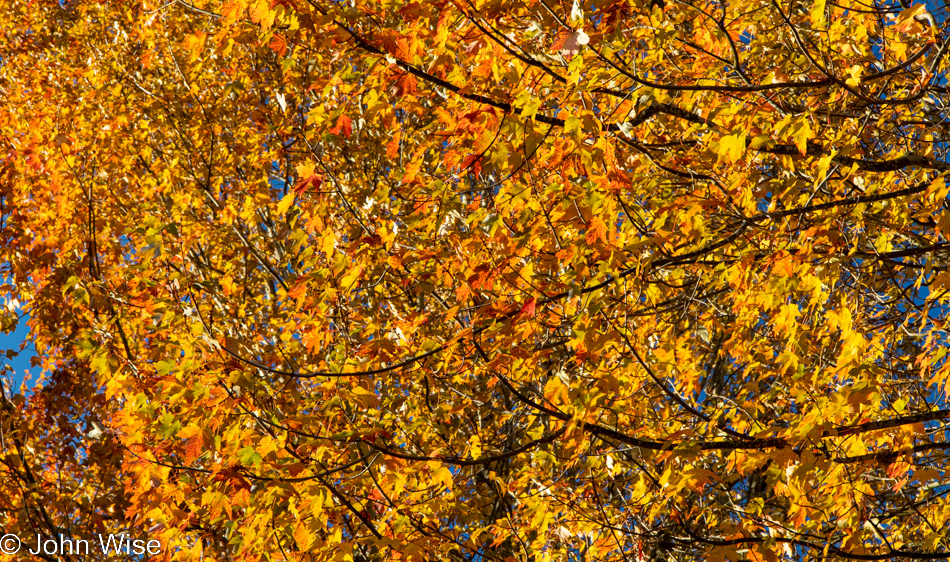
Nothing like being teleported out of the desert into a 24-degree (-4c) Pacific Northwest morning in a rental car without seat heaters or even one of those scraping things to de-ice our frosty windshield. While this disorienting shift of time zones (we gained a whole hour) is allowing for yet more experiences to seep into the potential of the day, we are somehow extraordinarily hungry and waste no time finding the closest establishment to satiate this need for hot food.
Sipping on Elmer’s Northwest Lodge Blend of coffee, we are watching the trees of fall catch the rising sun as we wait for the delivery of our first meal of the day. I’m writing with furious gusto as though that will speed the arrival of the egg dishes that should arrive any second, which in turn will allow us to get on the road pointed at an ocean beckoning for our return. Maybe part of my urgency to bounce out of here is related to our Super Walmart experience last night. Airlines should warn travelers when their destination is a parallel universe which might be contrary to the sensibilities of people who enjoy traveling to Europe, and to brace themselves for the risk of setting eyes on the homeless fentanyl crowd. Open sores and bedraggled fellows, kids hitting us up for cash in a store, that was not our scene.
Still, here this morning at Elmer’s, it is apparent that we’re in a damned slow-functioning resort for the obese, decrepit, conservative, and elderly curmudgeons. While I often enjoy eavesdropping on other tables, I draw the line when the dialog risks lowering my own I.Q. or contributing to the PTSD that grips my well-being when recognizing that I’m somewhere from whence I should try to escape posthaste.
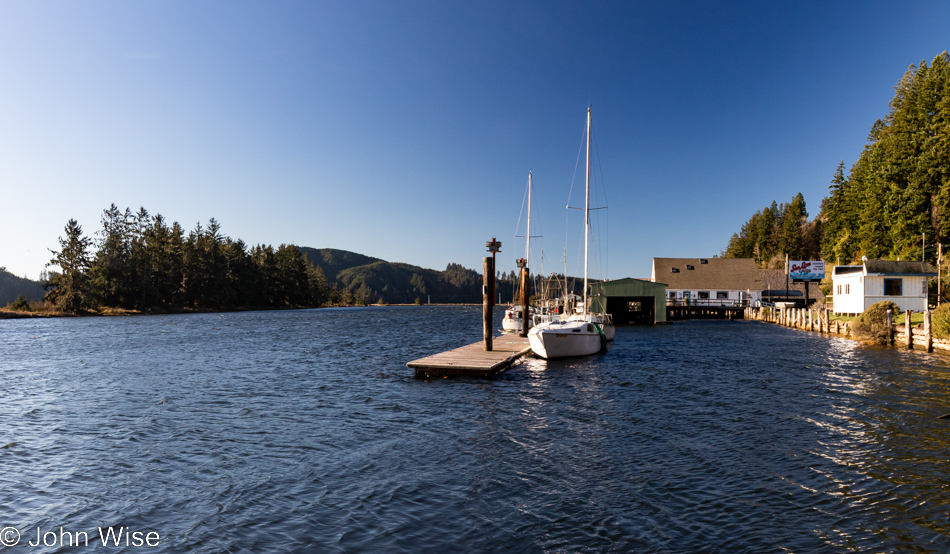
Our destination might be the ocean, but in a pinch, a river will do. We’ve pulled over here next to the Siuslaw River after having passed miles of great dark green forest, some of it so frosty as to be dusted in white, and with the coastal plain obviously just ahead, this was going to be one of the last moments to share at least something from the 75-minute long drive from Eugene that has brought us to the cusp of our dreams.

Hello again, dream world; it’s great to be back for our first glimpse of the sea here at Harbor Vista North Jetty in Florence.

One of us walks in the cold sand with their shoes on…
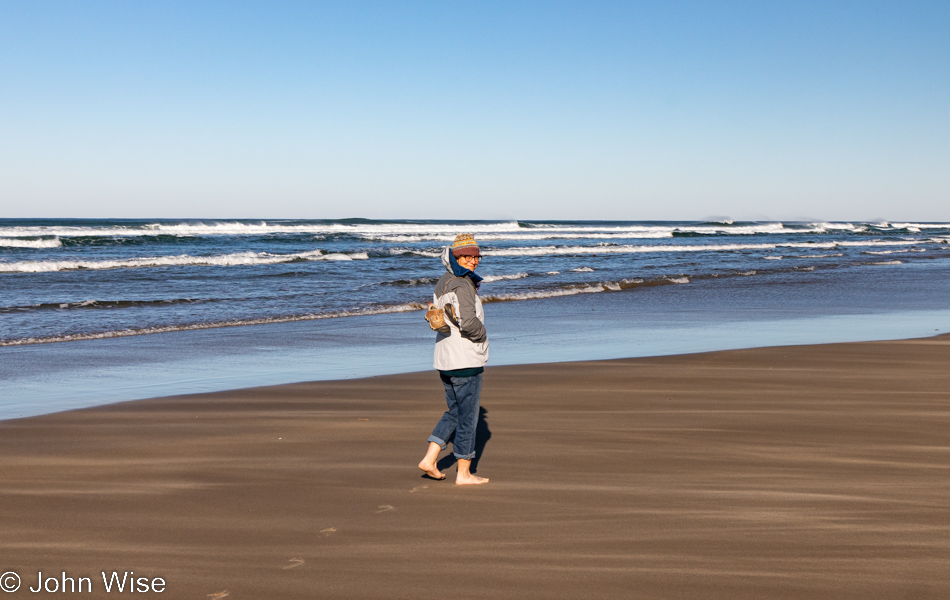
…the other must get her feet wet and feel the sand between her toes.

There’s no time to think, no time to talk, no time to write about impressions out here in the brisk ocean air that greets the cheeks of the desert dwellers. There is only time to feel, smell, and see something that is at once familiar and new all over again.

This thin blue line and the blowing sand keeping the ocean where it belongs is all that separates the land from the sea. Consider that the surface of the United States is roughly about 3 million square miles (8 million square kilometers), while the Pacific Ocean is approximately 171 million cubic miles (714 million cubic kilometers). Remember that this is a cubic dimension and not a square. Caroline and I have spent 25 years trying to explore these American states and have barely scratched the surface; no one will ever know the sea and what really happens in its vast depths.
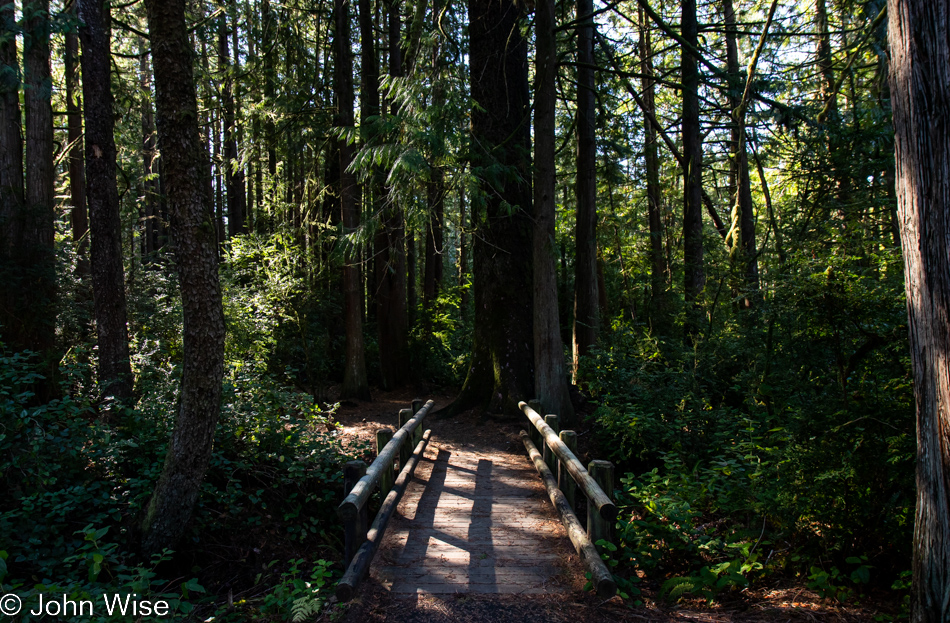
Old travel habits are hard to break, so why should today be different than other days? We made it 5 miles before Caroline asked me to pull over to the Darlingtonia State Natural Site, home of the cobra lily of the genus Darlingtonia.

This is only the second time we’ve stopped at this small wayside, and both have been during the late fall, but from the photos I took back in 2020, this year’s gathering of carnivorous lilies is looking a bit ragged, likely due to environmental factors though there’s not a botanist in sight to ask for clarification.

The day this plant emerged from its egg, it already had a taste for flesh and blood; else how does one explain a plant that eats creatures and ones that voluntarily crawl into its mouth? What, you say plants aren’t born from eggs? Well, that’s news to me or at least I’d like it to be if I stop to think about carnivorous plants because I’m at a loss for how they came about out of the mysteries of evolution.
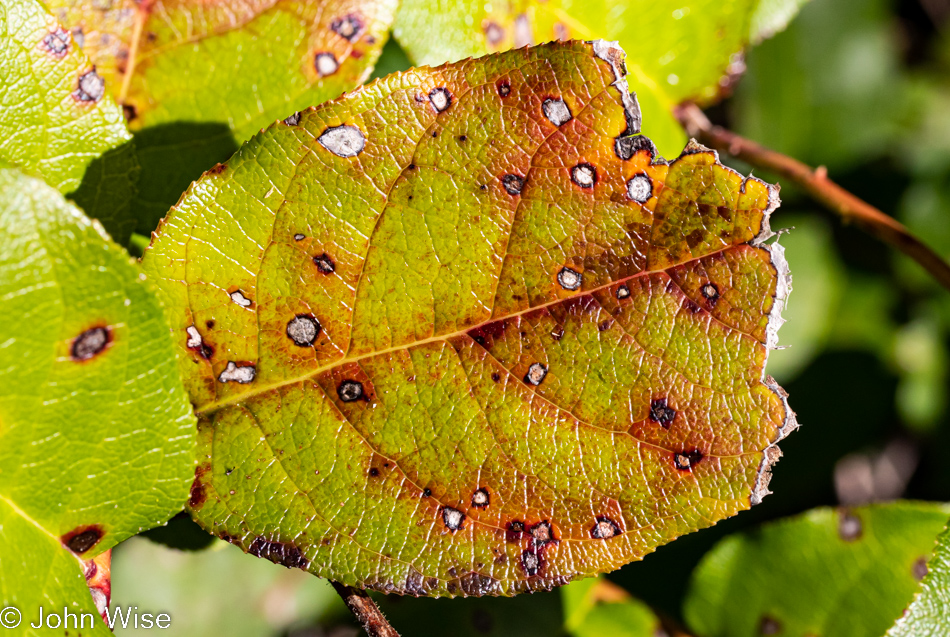
Knowledge might be far away from what little certainty I believe I have, but with my macro lens, I can attempt to bring near those things typically only experienced from a distance, such as smaller details found in this leaf suffering its demise with the changing season.
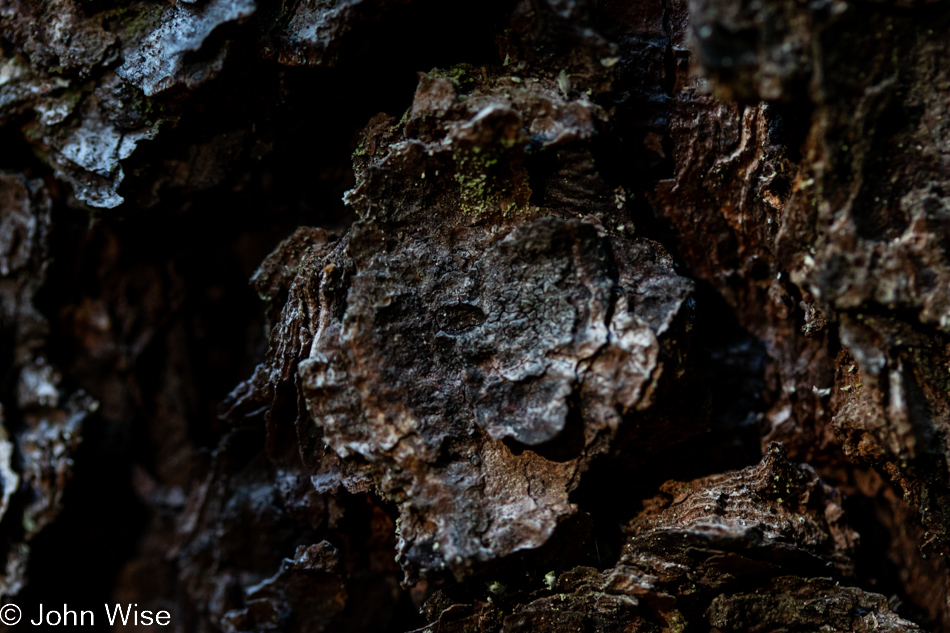
And then there’s this tiny piece of bark that might appear to be close to flaking off its tree, but for now, it’s a symbiotic piece of nature. On its surface, a bit of moss has taken hold, and behind the bark’s edges, I’m going to speculate that there’s a spider family, maybe some mites, or a pathway the local ants travel when out collecting stuff required for the colony. How many squirrels might have walked by or birds dropped in looking for snacks? I’d be willing to wager that I’m the first person to ever photograph this small specimen with such intimacy and that the chances of ever finding it again would be as successful as trying to locate a specific neuron in the 86 billion brain cells I have or a single plankton in those 187 quintillion gallons of water in the nearby Pacific Ocean.

Contemplating things some days earlier, I sketched a few rough ideas of how this first day on the coast might play out, but things are not going according to that guesswork and instead are being usurped by spontaneity and routine. Maybe 500 feet (150 meters) north of the wayside and across the street is the Happy Kamper Yarn Barn that we first visited ten years ago, nearly to the day. As anyone who’s read about our travels and stops at yarn stores already knows, we’ll not be leaving without new yarn, especially this fingering weight yarn that is destined to become yet one more pair of hand-knitted socks for me.
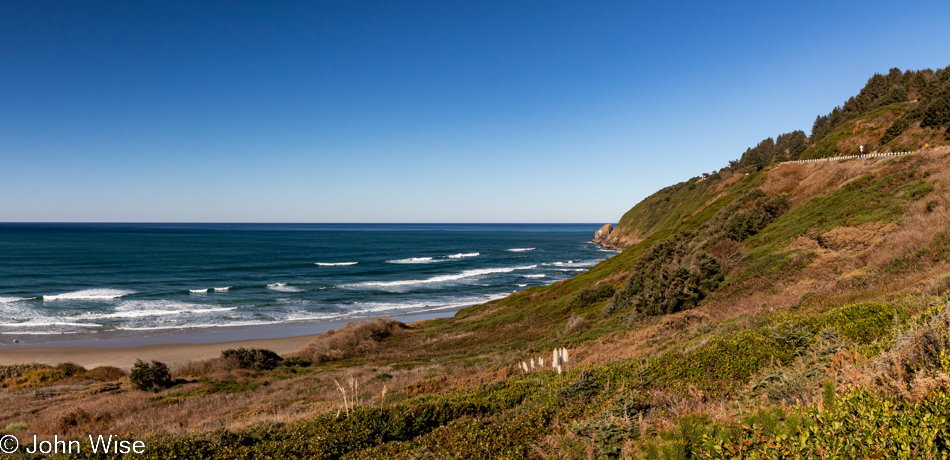
With instincts directing the wheel of the rental car, we drove north, though by now we knew that we’d not be attempting a slow walk in the rainforest of Washburne State Park as by the time we’d get out of that trap of the senses it would be seriously late considering we’d still have to make our way to the south coast where we’re staying this evening. So, if that’s not our goal, we might as well take our time, and it was right about then, while we were discussing options, that I thought I spotted something that required a turnaround. No, not just this view; although it’s certainly worthy, it was a little anomaly in the continuity of the coastal universe.
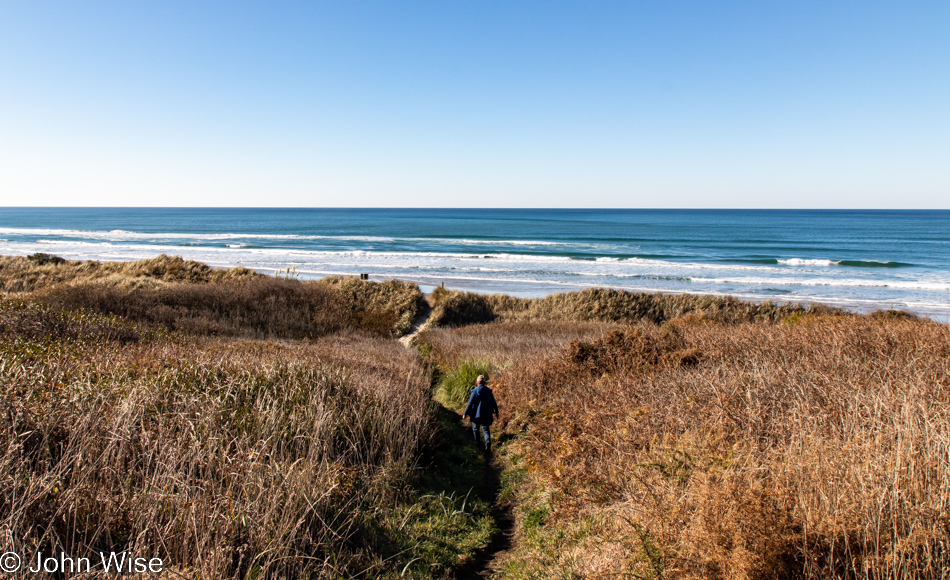
Just behind the guardrail, I thought I saw what looked like a small trail, and sure enough, that tiny gap quickly descended to a well-worn trail that took us right to the ocean’s edge and a place we’d never been to before.

It’s just a clump of rock with some barnacles on it, but it’s more than that. Maybe it’s part of primordial earth, or did it emerge as lava in the relatively recent past, ending up here on the beach reflecting itself back at me from the wet sand? Like the clouds overhead, it inspires me to find form in its shape; I see a whale here, albeit a small one. Should we ever revisit this particular beach, the likelihood of seeing this rock in just the same way is virtually zero. The sands will have shifted, the rock will give way to further erosion, or maybe a high tide will obscure it, and so in our view, the rock will be forever gone, just like a cloud passing overhead or our own lives passing down the beach.
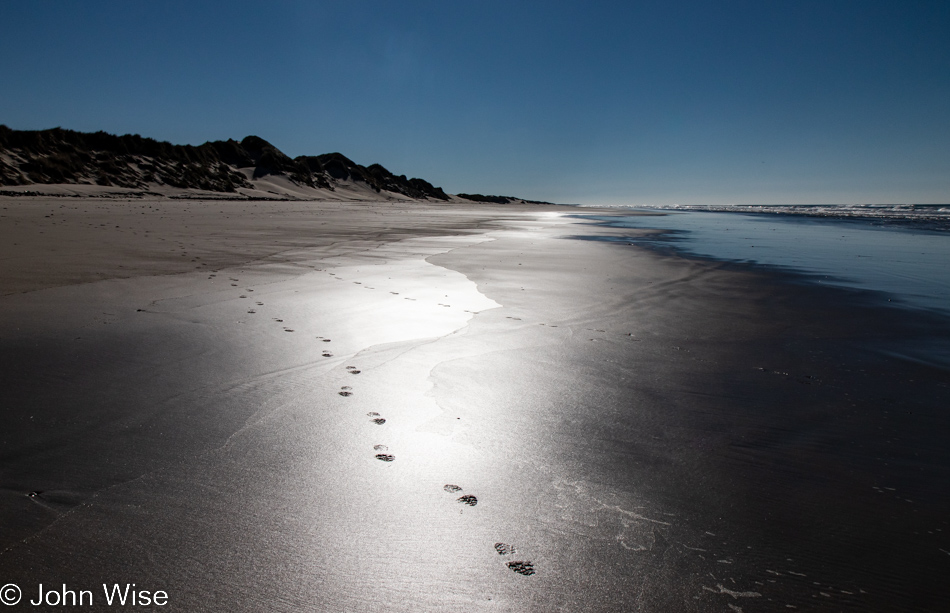
How many countless steps have we left in the sand, in the transitional, never-to-be-seen-the-same-way-again, shifting earth below our feet? From out of the distant past, we’ve witnessed with our own eyes the impressions of dinosaur feet frozen into stone. There’s a place where a child’s steps are right next to those of a wolf or large dog, and right over in New Mexico at the White Sands National Park are the tracks of a toddler and woman traveling across a playa that includes imprints from a mammoth and a giant sloth, and while those reminders that other species and people have walked over places we can visit today, the majority of impressions left by modern humans will fade and disappear. So, unless I figure out how to cast these words in stone, they, too, will become nothing more than the amorphous fabric that was left behind and recaptured by the elements, leaving no trace of what was there.
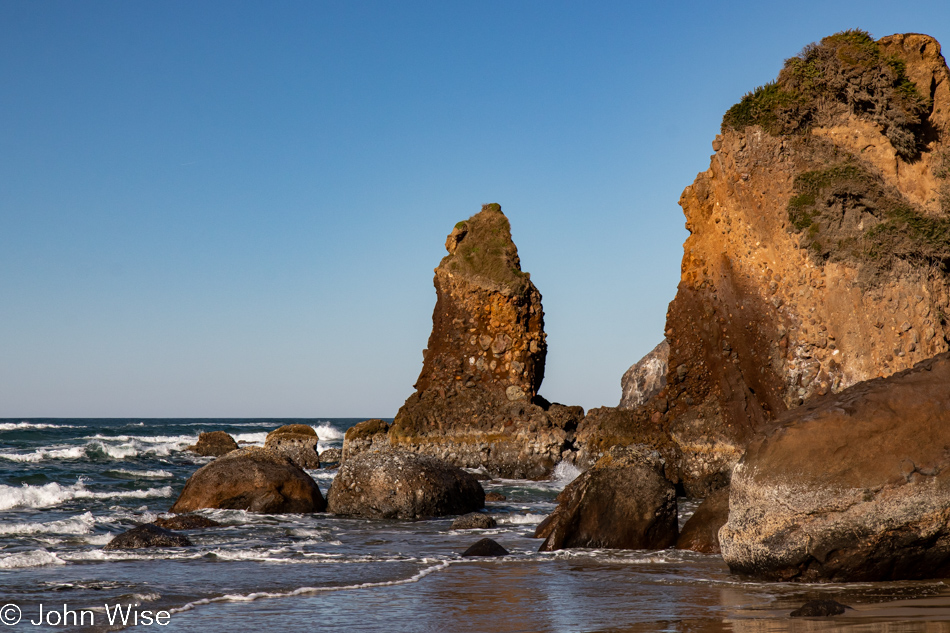
Even stone is not impervious to the ravages of time and the elements. All things will return to the sand and gasses of what in another form might have been the sustainers or protectors of life. Bastions, ramparts, armor, lungs, or thick leathery skin is no defense to the passage of this rare commodity measured by days, nights, and the cycles of a planet in relation to its sun. Knowing that you and everything you were will one day disappear, will you be content to simply have existed when, if you are reading this, you were likely born to a kind of privilege the majority of people on our planet can never know? Even if I’m but a grain of sand on this beach, I hope it’ll be the glimmering fleck that captures the eye of something out of the future that is enjoying its brief moment in existence.
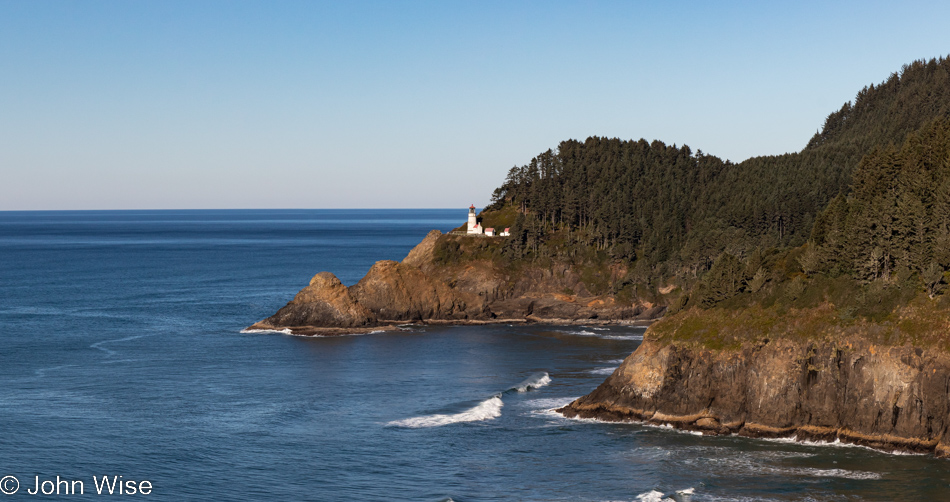
In a previous age, the lighthouse was a beacon to seafarers, warning of the dangers that they were approaching land. Nowadays, lighthouses act as tractor beams drawing us to their light, even when those lights were extinguished long ago.
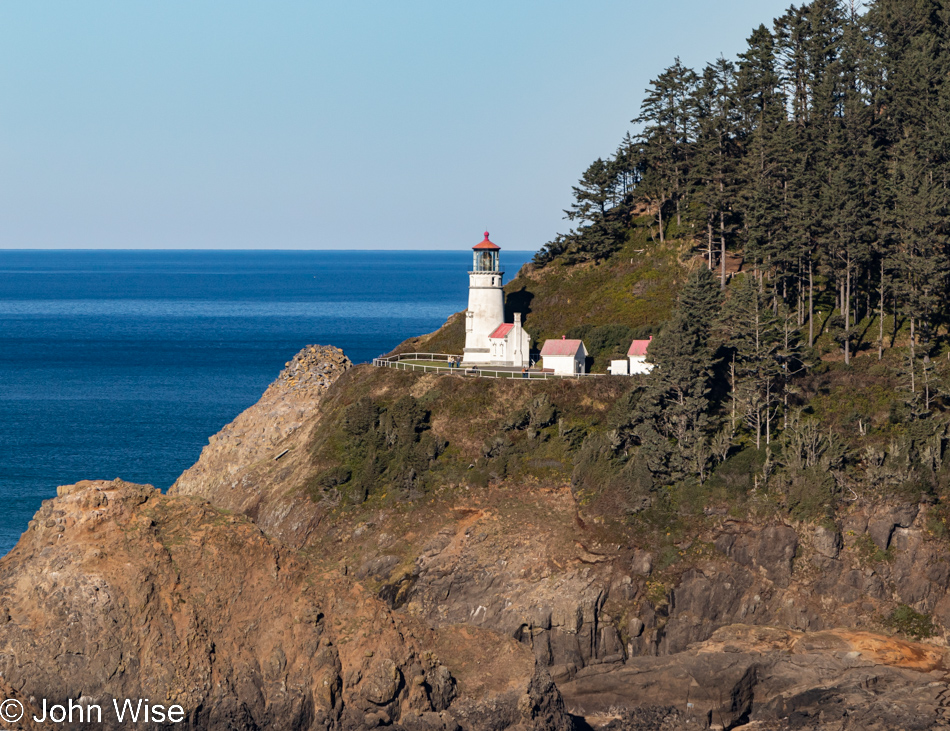
Instead of keeping us at a safe distance, they encourage us to come closer to revel in their rare existence and cherish their unique architectural characteristics. It’s easy to be drawn to a unique building, while a historic one offers intrinsic values that dig deep into our fascination that these things are still around. Take Jonathan, the tortoise who lives in Seychelles: he’ll celebrate his 190th birthday on December 4th this year. None of the curious people I know would turn down the chance to meet and touch this ancient, gentle animal. And for those of us fortunate enough to visit the over 4,000-year-old bristlecone pine trees of the Great Basin of Nevada or the prehistoric redwoods in California, we know the attraction of those things that have survived far longer than any of us gazing into the distant past.

If we take pause and think about it, we also enjoy and are drawn to experiencing the effects nature has played on the evolution of things, such as with sea lions basking in the sun below us as we were positioning ourselves to admire the Heceta Head Lighthouse. It was right here along the Oregon and Washington coasts that it’s believed the first flippered pinnipeds first showed up about 17 million years ago, but when we modern humans stop to look upon a tiny aspect of their lives, it is as though they just emerged from the sea for our enjoyment with little thought given to how many generations of sea lions came before them. My sense is that we have not yet developed an innate ability to appreciate the spectrum of time that life requires to arrive where it has. Maybe this is a negative side effect of religion, where we’ve used stories of magic and the supernatural to explain the mysteries that early humans were unable to comprehend.

It is out on the horizon of time (and trying to understand my relationship to it) where I look for the peace of mind that while I may not be able to experience the longevity of a tortoise or bristle cone pine tree, I’m at least capable of considering that I’m able to look back and forward into time’s domain and consider what I’ve learned from its passing and what I might still be able to do with what could lay ahead for me should I be around to explore new moments that are yet to be experienced in the future.
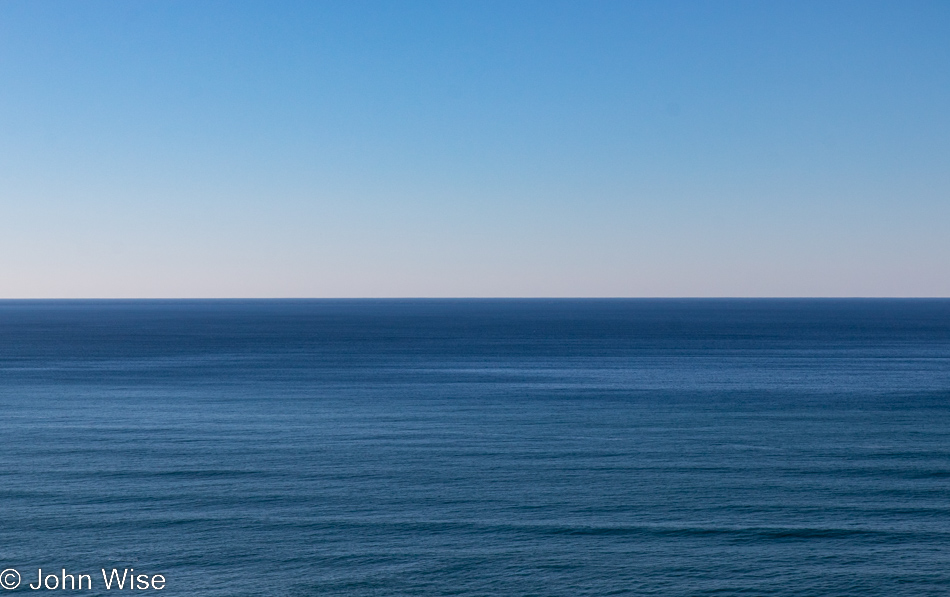
Out in the chaos of everything, the order of it all remains in constant flux as the energy of nature shifts things across time. The way I understand it, even constants have slight variations, but the contrivance of the arrogance of humans to find stasis is, in my view, hostile to the nature of our potential. Mind you, particular laws of nature and society should be respected, such as gravity containing oceans in their basins and our rules for penalizing transgressions against fellow humans and probably against the creatures with whom we share our space, too. Not that people are even near the precipice of unleashing our potential as the effect of centuries of uncertainty and the modern age exploiting fear has left our species afraid of the future, hence why we strive to contain variations that disturb the superficial surface of things.
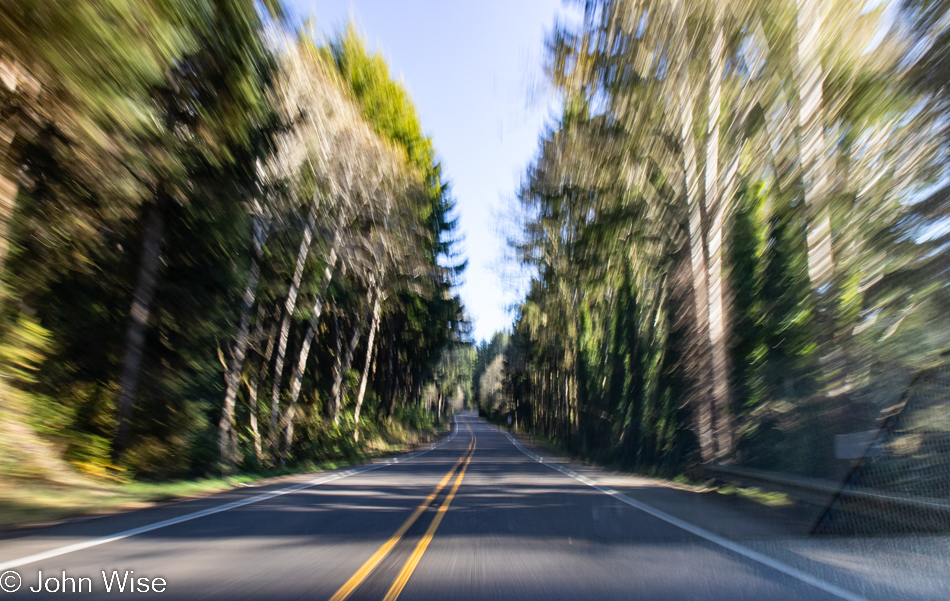
Where does the time go? One minute, you’re eating lunch at the Little Brown Cafe in Florence, not Italy, and the next moment, you become aware of the blur of having been driving south for hours, which is required if are going to reach Brookings down near the California state line by sunset. Being inland for much of the drive, it’s not like we could be distracted with a dozen oceanside stops, while the forest roads often barely have a shoulder, so even if we wanted to stop for photos of the afternoon sun lending a vibrant glow to the moss and hanging lichen on tree branches, we were stymied by highway engineers who neglected to add those important pullouts.
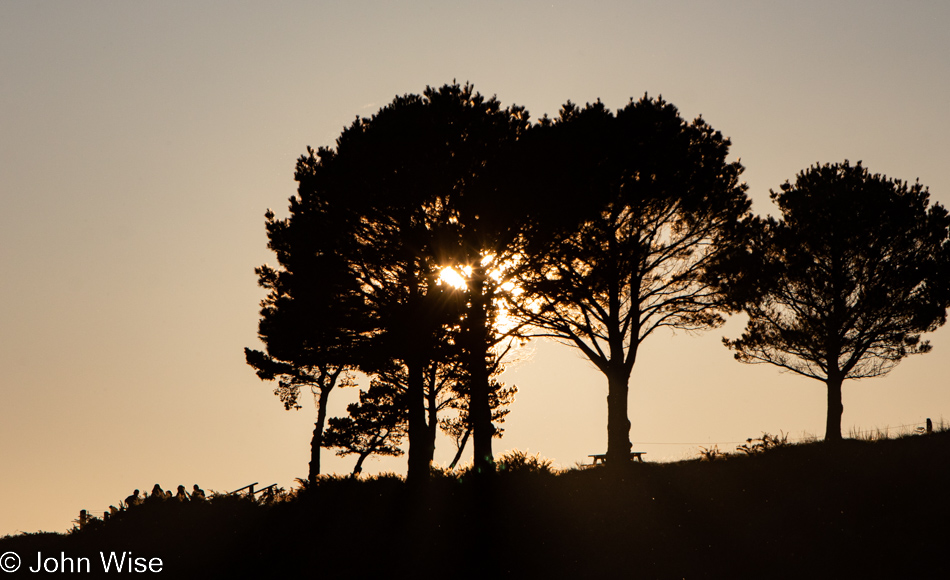
Choose your battles wisely, they always say, and so it was as the Wises pulled over at Battle Rock Wayside Park in Port Orford for the sunset as it was obvious that if it wasn’t now, it might not happen today if it was our hope to see a spectacular sunset.

While the famous Face Rock is found a couple of dozen miles north of us in Bandon, Oregon, this equally well-worn sister rock in Port Orford should be noted as a monument, too. Sadly, it is not, but from where I’m standing, I’d swear this is an Eastern Island Statue Face Rock and deserves recognition as such. Come to think about it, just on the left of it is Nipple Rock, and while you might want to jump to conclusions and see the two humps behind the nipple as boobs, I’d strongly disagree, though, as camel humps, I could see that. So, while not given the status or official name it should have, I present you with Camel Hump Nipple Statue Face Rock. [Nice try, John, but this rock is already noted and has a name – Tichenor Rock – Caroline]
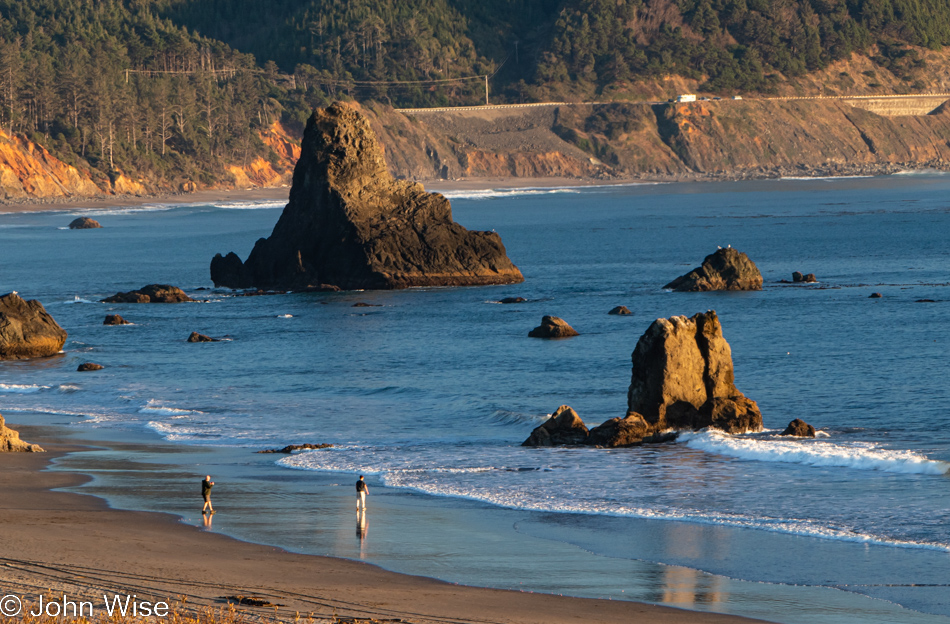
As soon as I’m satisfied that I’ve captured the various perspectives available from this overlook, we’ll turn our attention to putting ourselves down on that beach with the others to experience the sunset here.
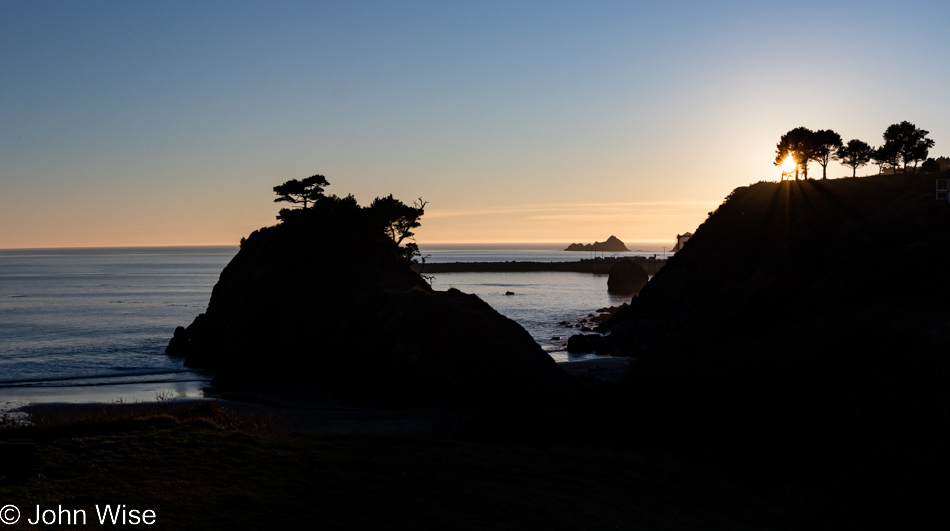
In my intro from yesterday morning, I spoke of things near and far and the lenses I’d bring to capture these spaces. I also offered hope that I’d do the same with the thinking I’d put forward in this post. While I may fail in the thinking and writing, this silhouette image contains elements from two images above the one prior, the trees in golden light and Camel Hump Nipple Statue Face Rock. In those two photos, I used a 70-200mm lens to bring to me what might have failed to be seen in previous visual encounters with the exact same places. The point this opens is that our perspective is often myopic. but more important than our vision being nearsighted, we need to look at our minds and those 86 billion brain cells whose capacity we cannot fathom. What if that gray matter in our skull is like the impossibly giant ocean, but instead of a great diversity of impressions and life, it were filled mostly with goldfish, plastic trash, and a fixed view that everything we know and will ever know is already mostly had? Well, if they are the brains of John and Caroline Wise, we will not relent in trying to discover what’s hidden in the places right before our faces as we share the idea that the onion-like layers of life experiences are near infinite while the time we’ve been afforded to glean them is but a brief interlude on the stage of the universe.
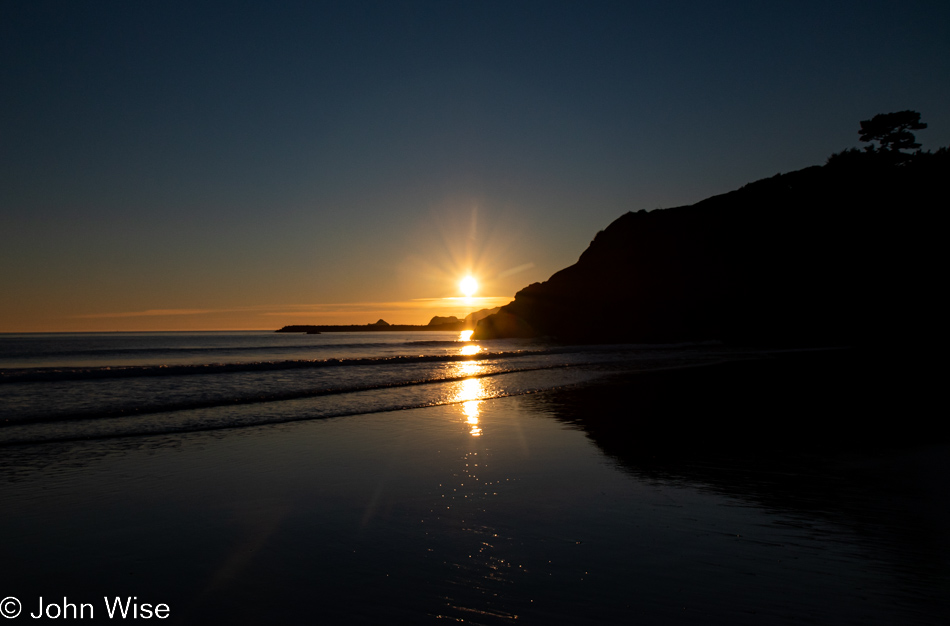
As above, does not always convey equally to, so below. While the height differential is minimal, just a short walk down a sandy trail and the changes offered to the senses are tremendous. Above, we cannot touch the shore, the surf, nor hear the world around us in quite the same way; we must go forward inching our way closer to touching the abyss of unknowns. Will the water be cold, the sand soft, and the sounds sharp or pleasant? We’ll not know, and should you accept conventional wisdom, you might come to believe that the Oregon coast would be too cold and hostile for your comfort or enjoyment at this time of year. I’d counter, even dare you to glance over the more than 100 posts on this blog that detail our experiences and see what we’ve captured and enjoyed. You can trust that we’ve heard, more times than we can remember, the voices of uncertainty that challenge our discretion about heading to such an inhospitable destination. I believe these are the same people who are able to convince themselves that most everything outside of their narrow routines could be fraught with discomfort and danger. Discovery is, after all, a dangerous curve that could challenge current beliefs, blinding one to mistaken certainty as though they’d looked into the sun.
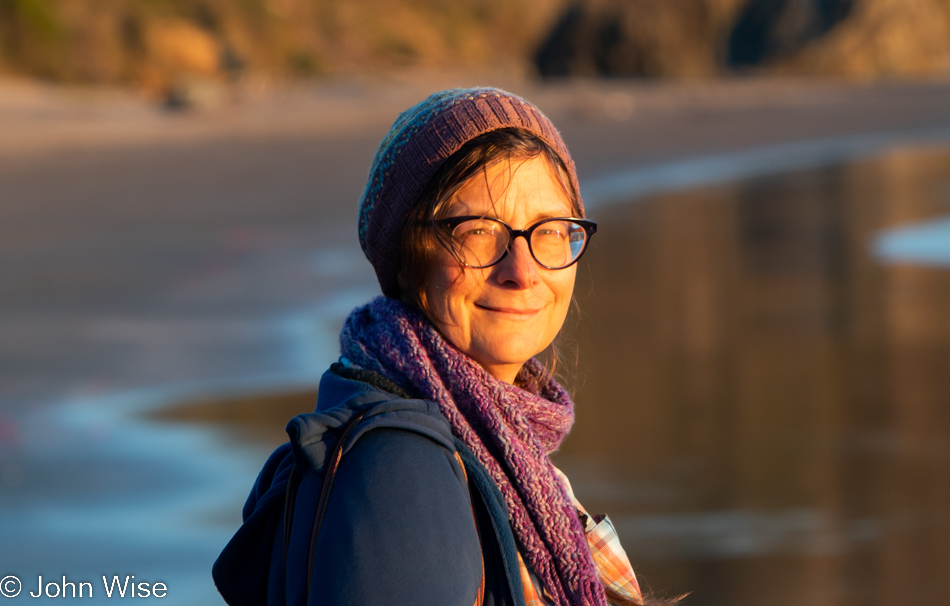
While I’ve only been so fortunate to be looking into this face of love for the past 33 years, those eyes that have been searching for knowledge, truth, and deep experiences have, in effect, been cultivating love in her heart her entire life. Instead of crashing into the wall of disappointment that love would never be found and shared, Caroline and I discovered one another and learned how to negotiate bumps on the shore, the gray clouds that occasionally obscure the sun, and have catered to each other’s insatiable thirst for the wow moments available to those who enjoy smiling. When I look into those eyes, I don’t only see a wife looking back; I see a long history of her delight in all the other things I’ve caught her smiling at, such as sand dollars, forests, rainbows, rocks, yarn, art, old people holding hands, a kite taking to the sky, her mom laughing, and words printed on a page. I’m fairly certain that Caroline doesn’t hold any secrets about the universe; I don’t believe she cares about having all the answers, but what I want to feel she has an abundance of is an intense curiosity that’s amplified by having someone with whom to share the experiences that arise from that.

What if I told you that the sun setting does not bring darkness but offers inner illumination of the heart for those who witness its descent below the horizon? How can I make such a claim? Caroline and I have watched the sunset countless times by now, and every time we do so, our smiles are beaming at one another for the rest of the day, which can only be explained by hearts bursting with energy fed by the sun, or do you have a better explanation?
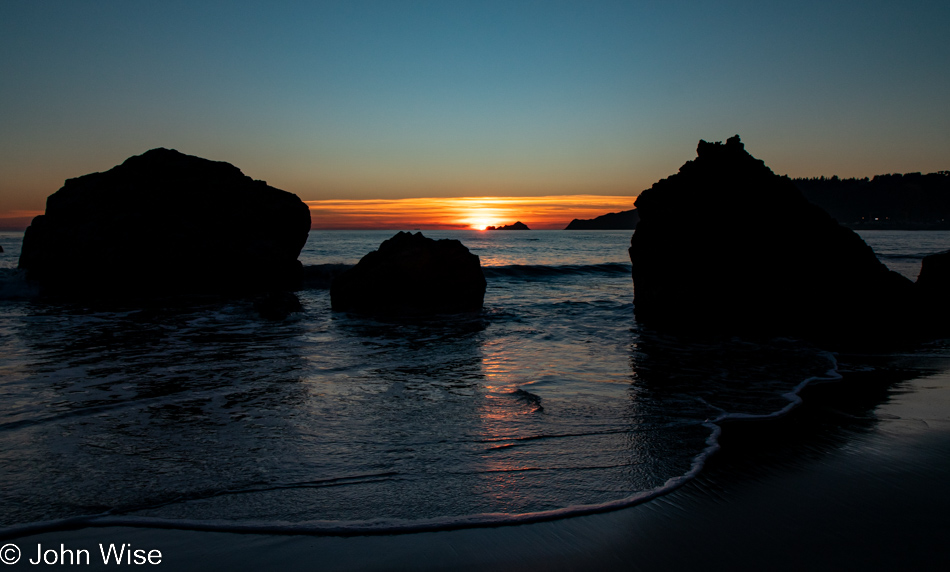
And what about those who just keep on seeing more sunsets? You guessed it, we likely have to giggle with each other at some point to let go of the abundance of beauty we were absorbing.
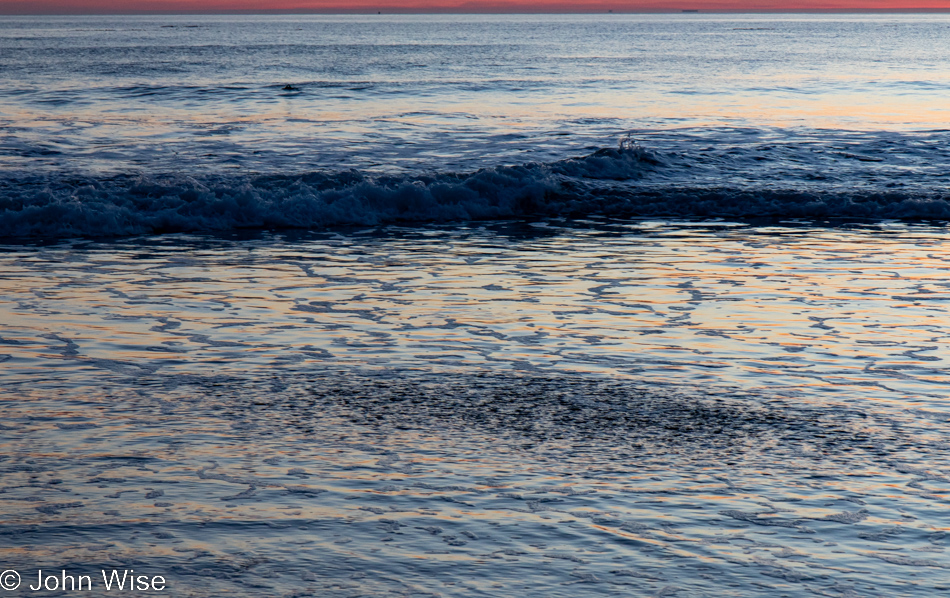
As for the effects wrought from gazing upon silver blue and golden orange water in those waning moments of the sun? We have not quite worked out how perfection cubed influences what is already beyond the charts of total wowness.
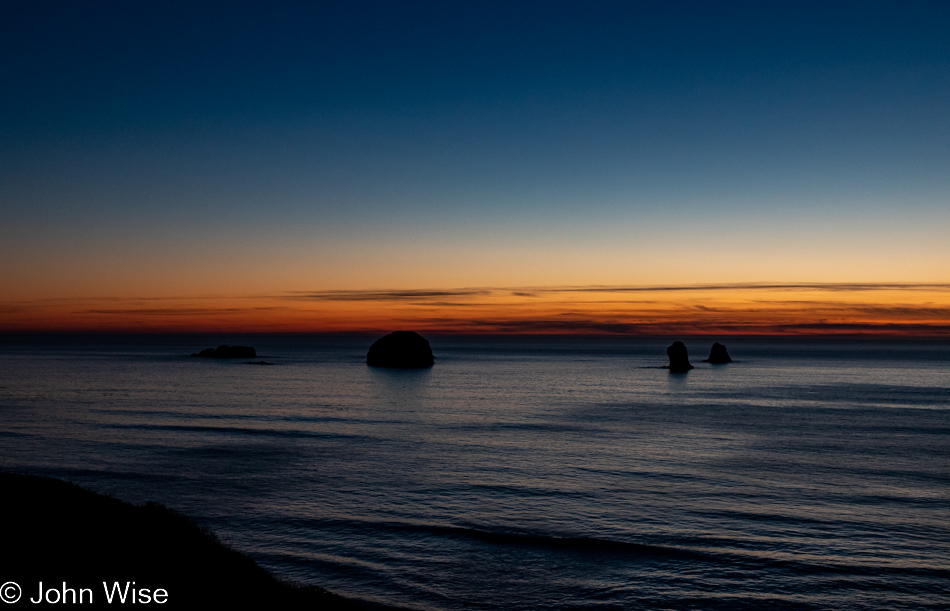
With senses aglow with the giddiness of having experienced a fantastic sunset at a wonderful spot nearing the end of our daylight hours, we were able to continue our adventure south. The dark silvery-gray sheen of the sea on our right, with a thin line of red-orange warmth of civil twilight, kept the purr of happiness moving along with us as the road ahead grew darker. Only an hour left before reaching the next magical place on our travel map.
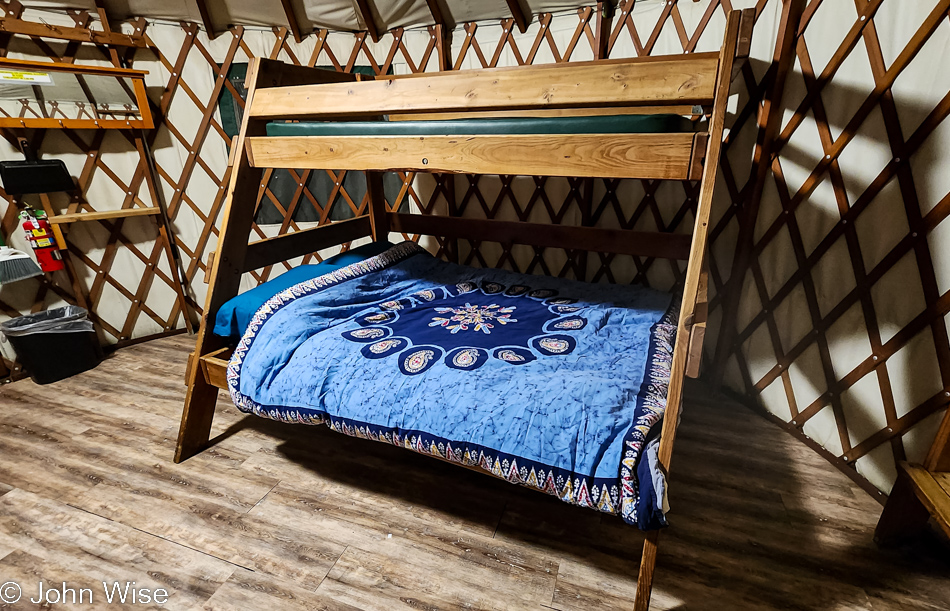
The crescendo hits as we drive into Harris Beach State Park and check into yurt C-26. The heater was already on, so the only thing left to do was drag our stuff in and make our bed before heading out for dinner while something might still be open. At this point, our elation nearly falls off a cliff as we’d be a whole lot happier to dip into an ice chest and crate of things from the car, but that was sacrificed in order to claim the extra time along the coast gained with flying up, so back to the car we reluctantly crawl.
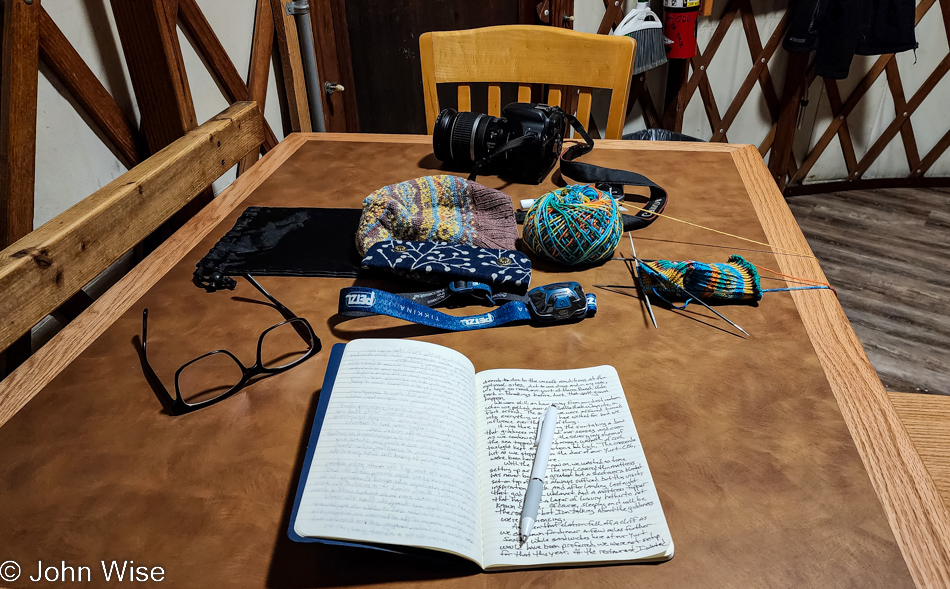
I have always loved pulling up to these tables for a writing session in the various yurts we’ve rented over these many years. Tonight, though, I find myself lethargic, apathetic even. As the pen meets the paper, the mind feels like the tide is going out. Sure, we are nearly 15 hours into this day, and a myriad of reasons can easily be identified, including last night’s late arrival, the difficulty found in sleeping on the first day out, a timezone change, my recent COVID recovery, and of course, that taskmaster called aging but none of these factors are welcome here on our vacation. I have demands, one is that I find productivity in the exercise of word transference from the mind through pen upon the open notebook that won’t be filling itself.
If I can find 10,000 steps, I should be able to locate a couple of thousand words that emerge from an experience that took in countless impressions. Instead of playing with a flow of words, I’m being drawn to the great outdoors, where stars beckon our imagination with silent calls to stand in awe of their magnitude filling the expanse of the inky sky we can hardly comprehend. The wind picks up and shakes bits and bobs from the trees that fall upon our yurt, nearly tricking us into believing it could be raining, though we know full well that the clear star-filled sky is the canopy set high over this campground tonight.
The rumble of crashing waves blends with the occasional passing of vehicles out on the highway, not that we expect the world for merely $50 a night but from our perspective, we are getting just that – the world. This form of perfection may not fit other’s ideas of luxury but for the two of us here this evening, our shared time is too fleeting not to understand the gift of the incredible when we find ourselves within it.
In my tired mind and body, I can find no profundity to wring out the intensity of today’s experience, which remains elusive to my right hand. Instead, I flick my wrist and see the clock ticked into the next hour, which can be perceived to be later than it is, at least back in Arizona. Now, I’m struggling to continue this splashing of ink onto paper and must concede that it’s time to splash a sleepy mind upon the waves of dreams that lay over the horizon of wakefulness. If I’m fortunate, tonight’s sleeping adventures will sneak in from the ocean, blow in on the breeze, or simply emerge from the delight of two traveling nerds deeply in love taking refuge in a cozy yurt.